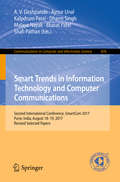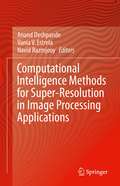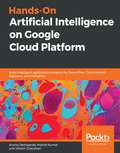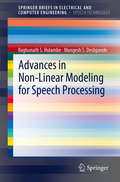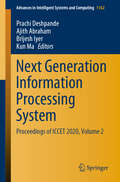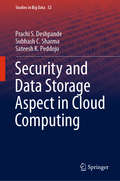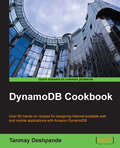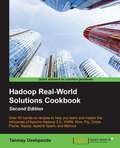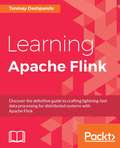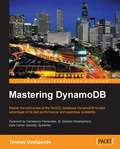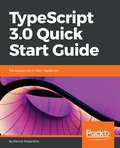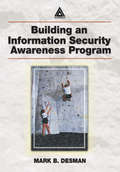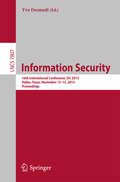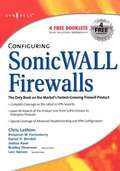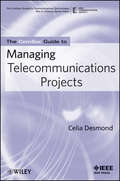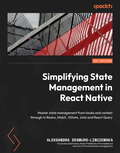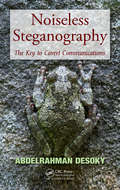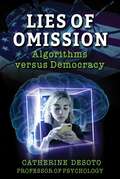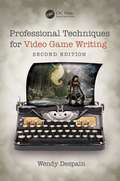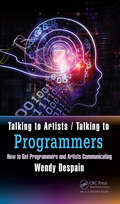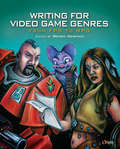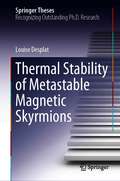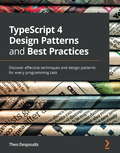- Table View
- List View
Smart Trends in Information Technology and Computer Communications: First International Conference, Smartcom 2016, Jaipur, India, August 6-7, 2016, Revised Selected Papers (Communications In Computer And Information Science #628)
by A. V. Deshpande Aynur Unal Kalpdrum Passi Dharm Singh Malaya Nayak Bharat Patel Shafi PathanThis book constitutes the refereed proceedings of the Second International Conference on Smart Trends in Information Technology and Computer Communications, SmartCom 2017, held in Pune, India, in August 2017.The 38 revised papers presented were carefully reviewed and selected from 310 submissions. The papers address issues on smart and secure systems; smart and service computing; smart data and IT innovations.
Computational Intelligence Methods for Super-Resolution in Image Processing Applications
by Anand Deshpande Vania V. Estrela Navid RazmjooyThis book explores the application of deep learning techniques within a particularly difficult computational type of computer vision (CV) problem ─ super-resolution (SR). The authors present and discuss ways to apply computational intelligence (CI) methods to SR. The volume also explores the possibility of using different kinds of CV techniques to develop and enhance the tools/processes related to SR. The application areas covered include biomedical engineering, healthcare applications, medicine, histology, and material science. The book will be a valuable reference for anyone concerned with multiple multimodal images, especially professionals working in remote sensing, nanotechnology and immunology at research institutes, healthcare facilities, biotechnology institutions, agribusiness services, veterinary facilities, and universities.
Hands-On Artificial Intelligence on Google Cloud Platform: Build intelligent applications powered by TensorFlow, Cloud AutoML, BigQuery, and Dialogflow
by Anand Deshpande Manish Kumar Vikram ChaudhariDevelop robust AI applications with TensorFlow, Cloud AutoML, TPUs, and other GCP services Key Features Focus on AI model development and deployment in GCP without worrying about infrastructure Manage feature processing, data storage, and trained models using Google Cloud Dataflow Access key frameworks such as TensorFlow and Cloud AutoML to run your deep learning models Book Description With a wide range of exciting tools and libraries such as Google BigQuery, Google Cloud Dataflow, and Google Cloud Dataproc, Google Cloud Platform (GCP) enables efficient big data processing and the development of smart AI models on the cloud. This GCP book will guide you in using these tools to build your AI-powered applications with ease and managing thousands of AI implementations on the cloud to help save you time. Starting with a brief overview of Cloud AI and GCP features, you'll learn how to deal with large volumes of data using auto-scaling features. You'll then implement Cloud AutoML to demonstrate the use of streaming components for performing data analytics and understand how Dialogflow can be used to create a conversational interface. As you advance, you'll be able to scale out and speed up AI and predictive applications using TensorFlow. You'll also leverage GCP to train and optimize deep learning models, run machine learning algorithms, and perform complex GPU computations using TPUs. Finally, you'll build and deploy AI applications to production with the help of an end-to-end use case. By the end of this book, you'll have learned how to design and run experiments and be able to discover innovative solutions without worrying about infrastructure, resources, and computing power. What you will learn Understand the basics of cloud computing and explore GCP components Work with the data ingestion and preprocessing techniques in GCP for machine learning Implement machine learning algorithms with Google Cloud AutoML Optimize TensorFlow machine learning with Google Cloud TPUs Get to grips with operationalizing AI on GCP Build an end-to-end machine learning pipeline using Cloud Storage, Cloud Dataflow, and Cloud Datalab Build models from petabytes of structured and semi-structured data using BigQuery ML Who this book is for If you're an artificial intelligence developer, data scientist, machine learning engineer, or deep learning engineer looking to build and deploy smart applications on Google Cloud Platform, you'll find this book useful. A fundamental understanding of basic data processing and machine learning concepts is necessary. Though not mandatory, familiarity with Google Cloud Platform will help you make the most of this book.
Advances in Non-Linear Modeling for Speech Processing (SpringerBriefs in Speech Technology)
by Mangesh S. Deshpande Raghunath S. HolambeAdvances in Non-Linear Modeling for Speech Processing includes advanced topics in non-linear estimation and modeling techniques along with their applications to speaker recognition. Non-linear aeroacoustic modeling approach is used to estimate the important fine-structure speech events, which are not revealed by the short time Fourier transform (STFT). This aeroacostic modeling approach provides the impetus for the high resolution Teager energy operator (TEO). This operator is characterized by a time resolution that can track rapid signal energy changes within a glottal cycle. The cepstral features like linear prediction cepstral coefficients (LPCC) and mel frequency cepstral coefficients (MFCC) are computed from the magnitude spectrum of the speech frame and the phase spectra is neglected. To overcome the problem of neglecting the phase spectra, the speech production system can be represented as an amplitude modulation-frequency modulation (AM-FM) model. To demodulate the speech signal, to estimation the amplitude envelope and instantaneous frequency components, the energy separation algorithm (ESA) and the Hilbert transform demodulation (HTD) algorithm are discussed. Different features derived using above non-linear modeling techniques are used to develop a speaker identification system. Finally, it is shown that, the fusion of speech production and speech perception mechanisms can lead to a robust feature set.
Next Generation Information Processing System: Proceedings of ICCET 2020, Volume 2 (Advances in Intelligent Systems and Computing #1162)
by Prachi Deshpande Ajith Abraham Brijesh Iyer Kun MaThis book gathers high-quality research papers presented at the International Conference on Computing in Engineering and Technology (ICCET 2020) [formerly ICCASP], a flagship event in the area of engineering and emerging next-generation technologies jointly organized by the Dr. Babasaheb Ambedkar Technological University and MGM’s College of Engineering in Nanded, India, on 9-11 January 2020. Focusing on next-generation information processing systems, this second volume of the proceedings includes papers on cloud computing and information systems, artificial intelligence and the Internet of Things, hardware design and communication, and front-end design.
Security and Data Storage Aspect in Cloud Computing (Studies in Big Data #52)
by Prachi S. Deshpande Subhash C. Sharma Sateesh K. PeddojuThis book analyses the various security threats in cloud computing. A host-based IDS (HIDS) using signature verification is developed and implemented for the concerned security issues. Further, owing to the vulnerability of distributed denial of service (DDoS) attacks in cloud computing, a network based IDS (NIDS) is developed and implemented against such attacks. The performance of these IDS is verified in the Cloud scenario as well against the standard data set. Finally, a simple data storage and security model is developed and implemented for the Cloud computing scenario. The contents of this book will be of interest to researchers and professionals alike.
DynamoDB Cookbook
by Tanmay DeshpandeOver 90 hands-on recipes to design Internet scalable web and mobile applications with Amazon DynamoDB About This Book * Construct top-notch mobile and web applications with the Internet scalable NoSQL database and host it on cloud * Integrate your applications with other AWS services like AWS EMR, AWS S3, AWS Redshift, and AWS CloudSearch etc. in order to achieve a one-stop application stack * Step-by-step implementation guide that provides real-world use with hands-on recipes Who This Book Is For This book is intended for those who have a basic understanding of AWS services and want to take their knowledge to the next level by getting their hands dirty with coding recipes in DynamoDB. What You Will Learn * Design DynamoDB tables to achieve high read and write throughput * Discover best practices like caching, exponential back-offs and auto-retries, storing large items in AWS S3, storing compressed data etc. * Effectively use DynamoDB Local in order to make your development smooth and cost effective * Implement cost effective best practices to reduce the burden of DynamoDB charges * Create and maintain secondary indexes to support improved data access * Integrate various other AWS services like AWS EMR, AWS CloudSearch, AWS Pipeline etc. with DynamoDB In Detail AWS DynamoDB is an excellent example of a production-ready NoSQL database. In recent years, DynamoDB has been able to attract many customers because of its features like high-availability, reliability and infinite scalability. DynamoDB can be easily integrated with massive data crunching tools like Hadoop /EMR, which is an essential part of this data-driven world and hence it is widely accepted. The cost and time-efficient design makes DynamoDB stand out amongst its peers. The design of DynamoDB is so neat and clean that it has inspired many NoSQL databases to simply follow it. This book will get your hands on some engineering best practices DynamoDB engineers use, which can be used in your day-to-day life to build robust and scalable applications. You will start by operating with DynamoDB tables and learn to manipulate items and manage indexes. You will also discover how to easily integrate applications with other AWS services like EMR, S3, CloudSearch, RedShift etc. A couple of chapters talk in detail about how to use DynamoDB as a backend database and hosting it on AWS ElasticBean. This book will also focus on security measures of DynamoDB as well by providing techniques on data encryption, masking etc. By the end of the book you'll be adroit in designing web and mobile applications using DynamoDB and host it on cloud. Style and approach An easy-to-follow guide, full of real-world examples, which takes you through the world of DynamoDB following a step-by-step, problem-solution based approach.
Hadoop Real-World Solutions Cookbook - Second Edition
by Tanmay DeshpandeOver 90 hands-on recipes to help you learn and master the intricacies of Apache Hadoop 2.X, YARN, Hive, Pig, Oozie, Flume, Sqoop, Apache Spark, and Mahout About This Book * Implement outstanding Machine Learning use cases on your own analytics models and processes. * Solutions to common problems when working with the Hadoop ecosystem. * Step-by-step implementation of end-to-end big data use cases. Who This Book Is For Readers who have a basic knowledge of big data systems and want to advance their knowledge with hands-on recipes. What You Will Learn * Installing and maintaining Hadoop 2.X cluster and its ecosystem. * Write advanced Map Reduce programs and understand design patterns. * Advanced Data Analysis using the Hive, Pig, and Map Reduce programs. * Import and export data from various sources using Sqoop and Flume. * Data storage in various file formats such as Text, Sequential, Parquet, ORC, and RC Files. * Machine learning principles with libraries such as Mahout * Batch and Stream data processing using Apache Spark In Detail Big data is the current requirement. Most organizations produce huge amount of data every day. With the arrival of Hadoop-like tools, it has become easier for everyone to solve big data problems with great efficiency and at minimal cost. Grasping Machine Learning techniques will help you greatly in building predictive models and using this data to make the right decisions for your organization. Hadoop Real World Solutions Cookbook gives readers insights into learning and mastering big data via recipes. The book not only clarifies most big data tools in the market but also provides best practices for using them. The book provides recipes that are based on the latest versions of Apache Hadoop 2.X, YARN, Hive, Pig, Sqoop, Flume, Apache Spark, Mahout and many more such ecosystem tools. This real-world-solution cookbook is packed with handy recipes you can apply to your own everyday issues. Each chapter provides in-depth recipes that can be referenced easily. This book provides detailed practices on the latest technologies such as YARN and Apache Spark. Readers will be able to consider themselves as big data experts on completion of this book. This guide is an invaluable tutorial if you are planning to implement a big data warehouse for your business. Style and approach An easy-to-follow guide that walks you through world of big data. Each tool in the Hadoop ecosystem is explained in detail and the recipes are placed in such a manner that readers can implement them sequentially. Plenty of reference links are provided for advanced reading.
Mastering Apache Flink
by Tanmay DeshpandeBig data developers who are looking to process batch and real-time data on distributed systems. Basic knowledge of Hadoop and big data is assumed. Reasonable knowledge of Java or Scala is expected.
Mastering DynamoDB
by Tanmay DeshpandeIf you have interest in DynamoDB and want to know what DynamoDB is all about and become proficient in using it, this is the book for you. If you are an intermediate user who wishes to enhance your knowledge of DynamoDB, this book is aimed at you. Basic familiarity with programming, NoSQL, and cloud computing concepts would be helpful.
TypeScript 3.0 Quick Start Guide: The easiest way to learn TypeScript
by Patrick DesjardinsWork with everything you need to create TypeScript applicationsKey FeaturesLearn enough about all aspects of TypeScriptAnswers the questions that new users ask about TypeScriptFocus on simple examples and concise explanationsBook DescriptionTypeScript is designed for the development of large applications and can be used to develop JavaScript applications for both client-side and server-side execution. This book is the ideal introduction to TypeScript, covering both the basics and the techniques you need to build your own applications.We start by setting up the environment and learning about the build tools that support TypeScript. Then we look at scoping of a variable, and the difference between a undefined variable and a null variable. You will then see the difference between an object, an Object, an object literal, and an object built with a constructor, crucial concepts in understanding TypeScript.You will learn how to make your code more generic to increase the reusability of your classes, functions, and structures, and to reduce the burden of duplicating code. We look at creating definition files to transform the actual JavaScript code to be compatible with TypeScript. By the end of the book, you will have worked with everything you need to develop stunning applications using TypeScript.What you will learnSet up the environment quickly to get started with TypeScript Configure TypeScript with essential configurations that run along your codeStructure the code using Types and Interfaces to create objects Demonstrate how to create object-oriented code with TypeScriptAbstract code with generics to make the code more reusableTransform the actual JavaScript code to be compatible with TypeScriptWho this book is forThis book is for JavaScript developers who want to get started with TypeScript for building applications. No previous knowledge of TypeScript is expected.
Building an Information Security Awareness Program
by Mark B. DesmanIn his latest book, a pre-eminent information security pundit confessed that he was wrong about the solutions to the problem of information security. It's not technology that's the solution, but the human factor-people. But even infosec policies and procedures are insufficient if employees don't know about them, or why they're important, or what ca
Information Security
by Yvo DesmedtThis book constitutes the thoroughly refereedpost-conference proceedings of the 16th International Conference on InformationSecurity, ISC 2013, held in Dallas, Texas, in November 2013. The 16 revised full papers presented together with 14short papers were carefully reviewed and selected from 70 submissions. Thepapers cover a wide range of topics in the area of cryptography andcryptanalysis and are organized in the following topical sections: security ofoperating systems; secret sharing; encryption; malware and Criticalinfrastructures; cryptanalysis; block ciphers and stream ciphers; entityauthentication; usability & risk perception; access control; computersecurity; privacy attacks; cryptography.
The Psychology of Totalitarianism
by Mattias DesmetThe world is in the grips of mass formation—a dangerous, collective type of hypnosis—as we bear witness to loneliness, free-floating anxiety, and fear giving way to censorship, loss of privacy, and surrendered freedoms. It is all spurred by a singular, focused crisis narrative that forbids dissident views and relies on destructive groupthink. Desmet’s work on mass formation theory was brought to the world’s attention on The Joe Rogan Experience and in major alternative news outlets around the globe. Read this book to get beyond the sound bites! Totalitarianism is not a coincidence and does not form in a vacuum. It arises from a collective psychosis that has followed a predictable script throughout history, its formation gaining strength and speed with each generation—from the Jacobins to the Nazis and Stalinists—as technology advances. Governments, mass media, and other mechanized forces use fear, loneliness, and isolation to demoralize populations and exert control, persuading large groups of people to act against their own interests, always with destructive results. In The Psychology of Totalitarianism, world-renowned Professor of Clinical Psychology Mattias Desmet deconstructs the societal conditions that allow this collective psychosis to take hold. By looking at our current situation and identifying the phenomenon of “mass formation”—a type of collective hypnosis—he clearly illustrates how close we are to surrendering to totalitarian regimes. With detailed analyses, examples, and results from years of research, Desmet lays out the steps that lead toward mass formation, including: An overall sense of loneliness and lack of social connections and bonds A lack of meaning—unsatisfying “bullsh*t jobs” that don’t offer purpose Free-floating anxiety and discontent that arise from loneliness and lack of meaning Manifestation of frustration and aggression from anxiety Emergence of a consistent narrative from government officials, mass media, etc., that exploits and channels frustration and anxiety In addition to clear psychological analysis—and building on Hannah Arendt’s essential work on totalitarianism, The Origins of Totalitarianism—Desmet offers a sharp critique of the cultural “groupthink” that existed prior to the pandemic and advanced during the COVID crisis. He cautions against the dangers of our current societal landscape, media consumption, and reliance on manipulative technologies and then offers simple solutions—both individual and collective—to prevent the willing sacrifice of our freedoms. “We can honor the right to freedom of expression and the right to self-determination without feeling threatened by each other,” Desmet writes. “But there is a point where we must stop losing ourselves in the crowd to experience meaning and connection. That is the point where the winter of totalitarianism gives way to a spring of life.” “Desmet has an . . . important take on everything that’s happening in the world right now.”—Aubrey Marcus, podcast host “[Desmet] is waking a lot of people up to the dangerous place we are now with a brilliant distillation of how we ended up here.”—Robert F. Kennedy, Jr.
Configuring SonicWALL Firewalls
by Simon Desmeules Barry J. StiefelConfiguring SonicWALL Firewal is the first book to deliver an indepth look at the SonicWALL firewall product line. It covers all of the aspects of the SonicWALL product line from the SOHO devices to the Enterprise SonicWALL firewalls. Also covered are advanced troubleshooting techniques and the SonicWALL Security Manager. This book offers novice users a complete opportunity to learn the SonicWALL firewall appliance. Advanced users will find it a rich technical resource.
The ComSoc Guide to Managing Telecommunications Projects (The ComSoc Guides to Communications Technologies #7)
by Celia DesmondThis pocket guide provides an overview of the telecommunications environment as it has evolved over the past few years, illustrating the need for project management, the significance of project success to the companies, and the application of key project management processes within the telecom environment. Topics covered include: scope management, time management, cost management, procurement management, risk management, communications, quality, human resources, and Integration. It offers professionals a brief and accessible guide to managing telecommunication projects in the 21st century.
Simplifying State Management in React Native: Master state management from hooks and context through to Redux, MobX, XState, Jotai and React Query
by Aleksandra Desmurs-LinczewskaMake fact-based decisions by comparing different solutions and learning popular ways to manage state in React Native with clear guidelines and recommendations by a React Native expertKey FeaturesExplore the big picture of state management in React Native using the most simplified versionImplement state management solutions by building a social media clone appCompare different state solutions in a contained environment to choose the best fit for your future projectsBook DescriptionManaging state in a React Native app can be challenging as it is one of the most difficult concepts to grasp while learning React Native. This is because there are so many ways to do it, and because there is a lack of clear guidelines on what should be used and why.Simplifying State Management in React Native is a comprehensive introduction for those who are new to creating robust React Native apps that will have you up to speed in no time. You'll get to grips with the different state management strategies and libraries available. As you progress through the chapters, you'll try out different solutions, as well as compare and choose which solution is perfectly suited to your future projects and personal preferences. Finally, you'll create a social media clone app using all the concepts and examples that you've learned in this book.By the end of this book, you'll be able to take on existing projects that use various state management strategies and libraries, and confidently make decisions about state management.What you will learnStart out by going over the basic ReactJS “mindset”Explore all that ReactJS has to offer to manage state in apps by building an appUnderstand existing state management libraries such as Redux, MobX, XState, Jotai, and React QueryDecide which libraries you want to use in your appsDesign a social media app to fully understand state managementTry out all the solutions presented in the book in a social media clone appWho this book is forThis book is for junior developers, React Native developers, and mobile app developers who are already using React Native, but are also on the lookout for advice and for a broader view to manage the state and changes in their applications. Basic knowledge of ReactJS and React Native, as well as familiarity with JavaScript and general mobile app development concepts are needed to grasp the topics covered in this book.
Design and Architecture for Signal and Image Processing: 15th International Workshop, DASIP 2022, Budapest, Hungary, June 20–22, 2022, Proceedings (Lecture Notes in Computer Science #13425)
by Karol Desnos Sergio PertuzThis book constitutes the thoroughly refereed conference proceedings of the First International Workshop on Design and Architecture for Signal and Image Processing, DASIP 2022, held in Budaypest, Hungary in June 2022. The 13 full included in the volume were carefully reviewed and selected from 32 submissions. They are organized in the following topical sections: leading signal, image and video processing and machine learning in custom embedded, edge and cloud computing architectures and systems.
Noiseless Steganography: The Key to Covert Communications
by Abdelrahman DesokyAmong the features that make Noiseless Steganography: The Key to Covert Communications a first of its kind: The first to comprehensively cover Linguistic SteganographyThe first to comprehensively cover Graph SteganographyThe first to comprehensively cover Game SteganographyAlthough the goal of steganography is to prevent adversaries from suspe
Lies of Omission: Algorithms versus Democracy
by Catherine DeSotoA lie of omission—withholding needed information to correct a false belief. There is a sharp and more hostile divide emerging in the United States. The shift is documented by various polls, and the speed of the change is alarming. There are certainly contributing factors, but one factor is unique to the contemporary era: receiving the majority of our information via social media experiences. Media algorithms, and to some extent overt censorship, serve users curated content that is unlike what their neighbors receive.Lies of Omission brings together various perspectives on the causes and effects of the divided information streams. Psychology and neuroscience, combined with some historical jurisprudence, are woven together to spell out the dangers of the modern social media experience. Importantly, the human response can be understood as rooted in our psychology and neurochemistry. In part two of the book, eight hot button issues that have provoked deep divisions among American citizens are presented as well-researched, opposing-view chapters with a goal to lay bare the extent of the disinformation gap that we are living in. With the rise of ephemeral smart media, and the associated displacement of the permanently printed word, it is rare to have a clear idea of what persons who do not share our opinions actually believe, or why.The decimation of communal information sources is nearly complete. What can one do? One concrete step is to turn some of your attention away from curated, impermanent news and read a book. Read this book. Dr. Catherine DeSoto spells out why it is worth our time to be informed regarding the issues we care about: something your phone&’s curated media will never do for you. Open your mind to the quaint idea that one is not informed unless one understands the opposing view. Surprising all-new research regarding the political divide and the pandemic is included. Together with over 150 references, this book will be the definitive source documenting the effects of the media algorithm revolution.
Professional Techniques for Video Game Writing
by Wendy DespainThis second edition of Professional Techniques for Video Game Writing is updated with new chapters and new authors, but it’s still a no-nonsense guide to the professional craft of writing for video games. Not only does the text cover story and narrative elements, but it also addresses dialogue, documentation, and strategy guides. Seasoned video game writers each address a different topic, including the best way to break into the video game industry, how to be an efficient part of a team, and the principles of narrative design. The book also offers script samples, technical writing advice, effective writing tips, and suggestions for how to innovate in game narrative. Key Features Comprehensive enough for veterans and accessible enough for novices Goes into detail about how to write tutorials, script doctoring, and writing for AAA games Delivers invaluable experiences directly from writers in the games industry Full of practical advice from industry pros on how to get a job, and then how to get the job done Author Bio Wendy Despain has more than two decades of experience spearheading digital media projects. She has worked with teams around the world as a writer, narrative designer, producer, and consultant on interactive experiences ranging from video games to augmented reality. She’s worked with EA, Disney, Ubisoft, Cartoon Network, PBS, Marvel, and Wargaming. Currently, she’s a Production Director at ArenaNet, makers of the Guild Wars franchise. Her books include: Writing For Videogame Genres: From FPS to RPG Talking to Artists/Talking to Programmers 100 Principles of Game Design
Talking to Artists / Talking to Programmers: How to Get Programmers and Artists Communicating
by Wendy DespainArtists and programmers often work together on complex projects in stressful environments and things don’t always go smoothly. Miscommunication and misunderstandings are common as these two disciplines often use the same words to mean different things when they talk to each other. Unintentional slights can turn into long-held grudges and productivity grinds to a crawl. This is a "flip book" that contains two narratives in one. Turn the book one way and read one perspective; turn the book over and upside down and read the other perspective. The narratives can be read separately, one after the other, or in alternating chapters. Talking to Artists / Talking to Programmers can help anyone who wants to improve communication with artists and programmers. It’s set up like a foreign language dictionary, so it addresses the cultural norms, attitudes and customs surrounding the words each group uses, so you’ll know not just what the words in the glossary mean, you’ll know why they’re used that way and how to get communication flowing again. It addresses common reasons for communication problems between these two groups and provides specific suggestions for solutions. The unusual format allows for each side to be given equal weight - learn how to talk to artists starting on one side of the book, turn it over and learn how to talk to programmers. The whole book stresses the things artists and programmers have in common. Focused primarily on videogame developers, it also applies to other fields where tech and art have to work together, including web developers and teams building mobile apps. Anyone who wants to communicate better with programmers or artists - this book can help Features Lists of common problems and strategies for solving them Specific ideas for building bridges between departments Case studies from real teams Glossary of terms causing the most confusion Explanations for common friction points Approaches for fostering goodwill Solutions for team dynamics problems Specific suggestions for providing feedback Ideas for holding successful meetings
Writing for Video Game Genres: From FPS to RPG
by Wendy DespainThis book, written and edited by members of the International Game Developers Association (IGDA) Game Writing Special Interest Group, follows the acclaimed Professional Techniques for Video Game Writing to deliver practical advice from seasoned veterans on the special challenges of writing for first-person shooter games (FPS), role-playing games (R
Thermal Stability of Metastable Magnetic Skyrmions (Springer Theses)
by Louise DesplatThe energy cost associated with modern information technologies has been increasing exponentially over time, stimulating the search for alternative information storage and processing devices. Magnetic skyrmions are solitonic nanometer-scale quasiparticles whose unique topological properties can be thought of as that of a Mobius strip. Skyrmions are envisioned as information carriers in novel information processing and storage devices with low power consumption and high information density. As such, they could contribute to solving the energy challenge.In order to be used in applications, isolated skyrmions must be thermally stable at the scale of years. In this work, their stability is studied through two main approaches: the Kramers' method in the form of Langer's theory, and the forward flux sampling method. Good agreement is found between the two methods. We find that small skyrmions possess low internal energy barriers, but are stabilized by a large activation entropy. This is a direct consequence of the existence of stable modes of deformation of the skyrmion. Additionally, frustrated exchange that arises at some transition metal interfaces leads to new collapse paths in the form of the partial nucleation of the corresponding antiparticle, as merons and antimerons.
TypeScript 4 Design Patterns and Best Practices: Discover effective techniques and design patterns for every programming task
by Theo DespoudisA detailed and easy-to-follow guide to learning design patterns and modern best practices for improving your TypeScript development skillsKey FeaturesUnderstand, analyze, and develop classical design patterns in TypeScriptExplore advanced design patterns taken from functional programming and reactive programmingDiscover useful techniques and gotchas when developing large-scale TypeScript applicationsBook DescriptionTypeScript is a superset language on top of JavaScript that introduces type safety and enhanced developer tooling. TypeScript 4 Design Patterns and Best Practices will assist with understanding design patterns and learning best practices for producing scalable TypeScript applications. It will also serve as handy documentation for future maintainers.This book takes a hands-on approach to helping you get up and running with the implementation of TypeScript design patterns and associated methodologies for writing testable code. You'll start by exploring the practical aspects of TypeScript 4 and its new features. The book will then take you through traditional gang of four (GOF) design patterns, such as behavioral, creational, and structural in their classic and alternative forms, and show you how you can use them in real-world development projects. Once you've got to grips with traditional design patterns, you'll advance to learning about their functional programming and reactive programming counterparts and how they can be coupled to deliver better and more idiomatic TypeScript code.By the end of this TypeScript book, you'll be able to efficiently recognize when and how to use the right design patterns in any practical use case and gain the confidence to work on scalable and maintainable TypeScript projects of any size.What you will learnUnderstand the role of design patterns and their significanceExplore all significant design patterns within the context of TypeScriptFind out how design patterns differ from design conceptsUnderstand how to put the principles of design patterns into practiceDiscover additional patterns that stem from functional and reactive programmingRecognize common gotchas and antipatterns when developing TypeScript applications and understand how to avoid themWho this book is forIf you're a developer looking to learn how to apply established design patterns to solve common programming problems instead of reinventing solutions, you'll find this book useful. You're not expected to have prior knowledge of design patterns. Basic TypeScript knowledge is all you need to get started with this book.
